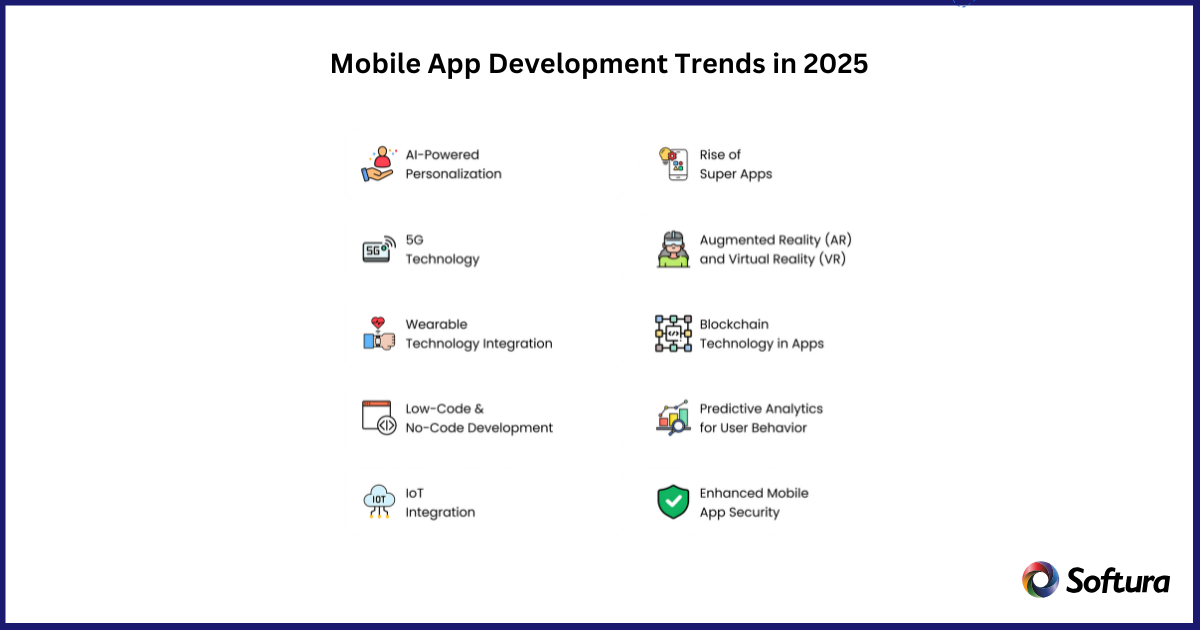"Our integration with the Google Nest smart thermostats through Aidoo Pro represents an unprecedented leap forward for our industry."
- Antonio Mediato, founder and CEO of Airzone.
The mobile app development market is projected to skyrocket to US$626 billion by 2030, but this is not just a numbers game; it is a strategic shift. The mandate for tech leaders, product owners, and innovation teams is clear: move beyond building apps and start building scalable ecosystems that adapt across platforms, devices, and dynamic user behaviors.
In 2025, success is not measured by flashy features alone. Performance, platform alignment, continuous delivery, and data-driven UX define the winners. If you are leading digital strategy, these eight trends will reveal how the smartest teams are staying ahead and how your organization can too.
"Our integration with the Google Nest smart thermostats through Aidoo Pro represents an unprecedented leap forward for our industry."
- Antonio Mediato, founder and CEO of Airzone.
Modern mobile app development teams break large applications into modular components to improve scalability and deployment velocity.
A modular architecture allows:
Modular architecture is rapidly becoming the standard for mobile engineering at scale. By breaking functionality into independent components, organizations accelerate release cycles, minimize regression risk, and enable parallel development, especially in CI/CD-driven environments. Yet even the most agile architectures must also prepare for real-world connectivity challenges where uptime is not guaranteed.
"By analyzing the data from our connected lights, devices and systems, our goal is to create additional value for our customers through data-enabled services that unlock new capabilities and experiences."
- Harsh Chitale, leader of Philips Lighting’s Professional Business.
Offline-first mobile experiences are critical, especially for healthcare, logistics, and utility sectors. Connectivity is not always guaranteed, and apps must work regardless.
Techniques include:
Offline-first architecture is no longer a niche approach; it is becoming essential for mobile applications expected to function in unpredictable environments. Teams that build with offline resilience from the start are seeing improved reliability, stronger user retention, and fewer service interruptions in the field. Reliability is critical, but engagement through intelligent interactions drives retention.
Push notifications are evolving from generic alerts to behavior-driven engagement tools.
Today’s best practices in mobile app development include:
Mobile engagement strategies are shifting from quantity to quality. Push notifications are now viewed as an extension of user experience that is highly personalized, intelligently timed, and adapted across devices. Leading teams leverage behavior analytics and real-time segmentation to make push communication more human and less interruptive. As user engagement expands beyond smartphones, mobile experiences must adapt to an increasingly connected device ecosystem.

Apps are no longer confined to phones. The rise of wearables, smart displays, and embedded devices demands new UX approaches.
Mobile app development teams must consider:
The device landscape is expanding fast, and so are user expectations. Modern mobile apps must now consider form factors beyond the phone. Designing wearables and smart devices requires developers to reimagine input, context, and responsiveness, using lightweight frameworks and modular UX systems tailored for dynamic environments. However, even the most innovative UX strategies must comply with evolving platform rules and governance standards.
Shifts in app store regulations affect every aspect of mobile app development, from billing flows to SDK selection.
Teams must now:
Governance is becoming a key variable in mobile architecture decisions. Platform policies, especially around monetization and data, reshape how apps are planned, structured, and released. Forward-looking teams are embedding compliance into their sprint planning, treating it as a product consideration rather than a post-release fix. Organizations are increasingly looking toward scalable, store-independent alternatives like Progressive Web Apps to navigate these new constraints.
Web-native mobile applications are gaining momentum as a fast, reliable, cost-effective alternative to traditional app delivery. These solutions combine the flexibility of web development with native-app quality experiences, blurring the lines between websites and native apps.
Organizations use them to:
These installable, responsive, and offline-ready apps are no longer fallback options; they have become go-to strategies for teams focused on speed, accessibility, and device-agnostic engagement. As delivery models evolve, designing mobile experiences that adapt fluidly across screens is now critical for scale and success.
Users now interact with apps on phones, tablets, foldable screens, and even desktop-class screens, which requires responsive, adaptive, and fluid UX design.
Mobile app development teams are embracing:
UX is no longer a surface-level concern. It is central to mobile strategy, especially in a world of foldables, tablets, and hybrid work devices. Teams adopt component-based design systems to maintain consistency, adapt fluidly across screen types, and reduce friction in feature delivery.
Mobile app development in 2025 is no longer about delivering functionality but building scalable, adaptable, and user-aligned systems. The most successful companies rethink their architecture, development strategy, and user experience in tandem.
From modular codebases and offline capabilities to platform compliance and wearable integration, each trend speaks to the growing need for flexibility and speed. Businesses that ignore these shifts risk falling behind in app performance, customer retention, and competitive differentiation.
If you are planning your next mobile initiative, Softura’s team is here to help you lead the shift. Connect with Softura’s mobile app development experts today to accelerate your digital innovation.
Ready to future-proof your mobile strategy?
Let’s explore how your business can adopt the latest development trends to deliver faster, smarter, and more scalable mobile experiences.
The three most important considerations when developing a mobile app are delivering a seamless user experience, ensuring the app can scale efficiently as usage grows, and implementing strong data security measures to protect user information.
Define your app’s goal, target audience, supported platforms, development timeline, and required system integrations to ensure a clear project roadmap.
For a successful mobile app, prioritize seamless user experience, scalability, strong security, performance optimization, and cross-platform compatibility.
Performance metrics should align with internal KPIs, tracking sprint velocity, quality of deliverables, error rates, and stakeholder feedback to ensure consistent outcomes.